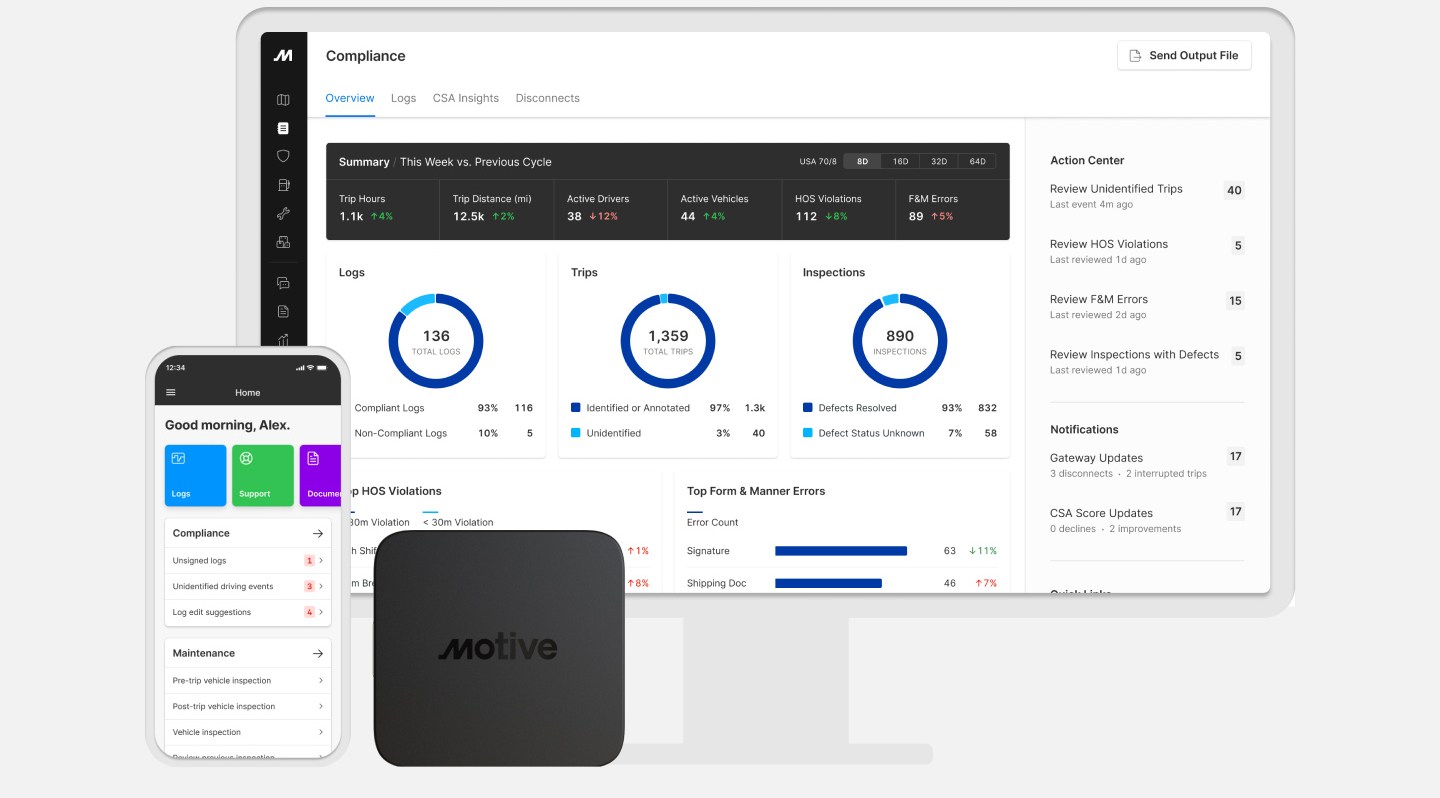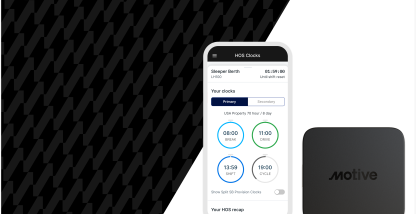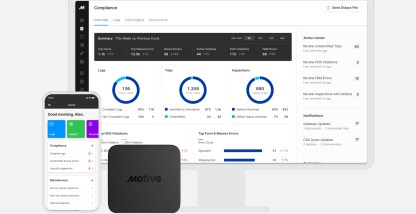Most commercial motor vehicle drivers now have to comply with the FMCSA mandate to be in ELD compliance.
But what is the ELD mandate? Who has to comply with it? And what are the ELD compliance requirements?
You’ve got questions. We’ve got answers.
Understanding the FMCSA’s ELD mandate can be complicated. There are a lot of moving parts. But it’s important to have a full grasp on the ELD rule and compliance requirements so commercial drivers can stay compliant.
Keep reading for everything you need to know about the ELD mandate.
What is the ELD mandate?
The FMCSA ELD mandate is a federal law. It says that commercial motor vehicle operators covered by the mandate have to use compliant electronic logging devices. Some CMV operators are exempt. But most have to comply with the FMCSA’s mandate.
The FMCSA works alongside with the U.S. Department of Transportation (DoT). Their primary goal is to improve road safety and reduce the number of accidents in the United States.
The main purpose of the ELD mandate is to create a safe environment for commercial drivers, reduce driver fatigue, enforce Hours of Service rules, and minimize road accidents.
In their own words…
“[FMCSA] announced the adoption of a Final Rule that will improve roadway safety by employing technology to strengthen commercial truck and bus drivers’ compliance with hours-of-service regulations that prevent fatigue.”
What is an ELD, and how does it work?
An ELD or Electronic Logging Device is electronic hardware that’s attached to a commercial motor vehicle engine to record driving hours (Hours of Service). ELDs monitor a vehicle’s engine and collects data on whether or not the engine is running. ELDS also record if the vehicle is moving, how many miles have been driven, and how long the engine has been operating.
ELDs can keep track of drivers in real-time. They help fleets with ELD compliance, vehicle inspections, planning, and overall fleet management. ELDs became mandatory for non-exempt commercial drivers after the implementation of the ELD mandate by the FMCSA.
Electronic logging devices are generally connected to a CMV (commercial motor vehicle), a mobile app for drivers, and fleet management software. The device then records the driver’s Hours of Service data and sends it to the mobile app for viewing. This data is also sent to the fleet management software for the back-office staff (compliance managers, safety officers, or fleet managers). So they can help drivers with ELD compliance.
What is ELD compliance?
In general, regulatory compliance means conforming to a rule. In this case, ELD compliance refers to complying with the Electronic Logging Device (ELD) mandate.
ELD compliance means non-exempt commercial drivers need to have an FMCSA-registered ELD solution and conform with other key ELD mandate requirements.
If a non-exempt driver does not have an electronic logging device when required, they can be put out-of-service for 10 hours and may also face violations and hefty fines. In addition, drivers can also be put out-of-service for using an unauthorized or non-compliant ELD solution and/or falsifying logs.
ELD mandate compliance: rules and regulations
When the FMCSA implemented the ELD mandate, they established four main requirements to meet and remain complaint. The final ELD rule:
- Established which drivers must comply with the ELD mandate
- Set design and performance standards that available electronic logging devices must meet in order to be compliant
- Identified the supporting documents that drivers and carriers must keep
- Protected drivers from harassment by detailing all of the required steps drivers need to take in order to comply
ELD compliance requirements
The ELD mandate requires ELDs to:
- Connect to the vehicle’s engine to record whether or not it is in motion
- Give the driver the option to log on and select a non-driving duty status. Either On-duty, Off-duty, or On-Duty, Not Driving.
- Supply data in a standardized format that can be transmitted to law enforcement in several prescribed ways, including wireless web services, USB, and Bluetooth
- Graphically show a Record of Duty Status (RODS), so the driver can quickly see the hours driven in a day
- Be provider-certified, meaning that the ELD meets the required technical specifications
The mandate says that an Electronic Logging Device must be on the FMCSA’s list of self-certified ELDs to be compliant. The FMCSA updates the list regularly.
ELD mandate timeline
When did ELDs become mandatory? The idea for the ELD mandate began in 2012. In March 2014, the FMCSA released its ELD proposal. On December 16, 2015, the final ELD rule was published by the FMCSA.
It was then implemented in three phases:
- Awareness and Transition. This phase refers to the period between February 16, 2016, to December 18, 2017. During this phase, motor carriers were encouraged to install ELDs on a voluntary basis.
- Phased-in Compliance. The second phase (from December 18, 2017, to December 16, 2019) required non-exempt drivers to install compliant electronic logging devices. Drivers could also use AOBRDs and remain compliant if AOBRDs were installed and in-use before December 18, 2017.
- Full Compliance. The third phase (after December 16, 2019) requires all non-exempt commercial drivers to use FMCSA compliant ELDs. AOBRDs no longer help compliance with the ELD mandate.
Here’s a visual way to understand the ELD mandate timeline:
AOBRDs and the ELD mandate
According to the ELD mandate timeline, non-exempt drivers can no longer use AOBRDs (Automatic Onboard Recording Devices) to remain compliant with the mandate.
AOBRDs were only applicable until December 16, 2019. Now, all qualifying drivers must use compliant ELDs.
In case you’re interested, there are many differences between AOBRDs and ELDs.
Who does the ELD mandate apply to?
There is no difference between the ELD mandate for truckers and the ELD mandate for owner-operators.
The ELD mandate applies to most motor carriers and drivers who are currently required to maintain Records of Duty Status, commonly referred to as RODS, as per Part 395, 49 CFR 395.8(a).
But, there are a few exemptions.
ELD mandate exemptions: who is exempt from the eld mandate?
Although the FMCSA’s final ELD rule applies to most commercial motor vehicle drivers, there are a few exemptions. The mandate does not apply to:
- Drivers who drive vehicles with pre-2000 engines
- Drivers in certain Driveaway-Towaway operations
- Drivers who are not required to maintain a Record of Duty Status (RODS)
- Drivers who only maintain RODS for 8 days or fewer in a rolling 30-day period
- Insect and livestock transporters
ELD compliance for local drivers
Not every trucker is an interstate, long-haul driver. Local delivery service drivers, plumbers, electricians, and many others also do quite a lot of driving.
Local fleets are not necessarily subject to the ELD mandate. But sometimes, even local truckers have to install electronic logging devices and comply with the ELD mandate.
Let’s look at an example. If you are a short-haul driver who has to maintain RODS for more than 8 days in a 30-day period, you need to comply with the mandate. Learn more about the short-haul exemption.
Note: The FMCSA has recently updated the short-haul exemption rule. Make sure to read the updated guidance.
Besides that, drivers should also know the intrastate rules that apply to them. For instance, there is an exemption in Florida for intrastate truckers hauling agricultural products within a 150 air-mile radius.
The use of ELDs for non-exempt intrastate drivers in Florida became mandatory from Jan. 1, 2020. Texas also mandated the use of electronic logging devices for intrastate drivers by Dec. 17, 2019.
Short-haul and other drivers who are exempt from the ELD mandate can still benefit tremendously from installing ELD devices. Many fleet management solution features can help a local fleet run more safely and efficiently. For example, GPS tracking and driver workflow management work together to help you simplify operations and dispatch the right driver and vehicle to each new job.
There are many ELD benefits for fleets of all types and sizes.
ELD mandate and the Hours of Service rules
In the past, paper logs or electronic on-board recorders (EOBRs) were used for HOS tracking. Even though an EOBR-style log delivered more accurate data than paper logs, the format still wasn’t consistent enough. The logs had to be re-done to a parallel “paper” format for review and enforcement. That’s an enormous waste of time and money.
The Record of Duty Status (RODS) definition within the ELD legislation defined a constant format for the enforcement personnel to review. That need for consistency became one of the main reasons why the ELD mandate was created. Remember, the mandate itself did not change the Hours of Service rules. The mandate simply facilitates enforcement.
The FMCSA regulates the number of hours commercial drivers may drive per day and/or per week. These rules are commonly referred to as Hours of Service rules or HOS rules.
These Hours of Service rules also include other restrictions, such as taking mandatory rest breaks. The goal behind these HOS rules? To regulate the number of hours driven in order to reduce dangerous conditions like drowsiness and driver fatigue.
The FMCSA has estimated that implementing the ELD mandate can help avoid 1,844 crashes and 562 injuries each year. It is also expected to save 26 lives each year. Studies revealed that Hours of Service compliance has improved after the ELD mandate.
Note that the ELD mandate itself did not introduce or change any Hours of Service regulations. The ELD rule is just a way to enforce the existing Hours of Service more strictly.
Having said that, the data these ELD devices collect is now becoming a catalyst for improving the existing Hours of Service rules. The trucking industry now finally has the insights it needed to see which HOS regulations need improvement.
Personal Conveyance and the ELD mandate
In the trucking industry, Personal Conveyance refers to the movement of a commercial motor vehicle (CMV) for personal use while the driver is off duty.
Personal Conveyance rules are covered in the ELD mandate, and some of those rules have been updated. The updates gave drivers a little more flexibility when it comes to off duty time. But drivers should be aware of some caveats.
Here’s a few examples of what the FMCSA does not qualify as Personal Conveyance:
- Moving a commercial motor vehicle to enhance the operational readiness of a motor carrier
- Continuing a trip in interstate commerce to fulfill a business purpose, such as bobtailing, retrieving another load, or repositioning a commercial motor vehicle at the direction of the carrier
- Time spent driving a passenger-carrying CMV while passengers are on board
- Time spent transporting a commercial motor vehicle to a facility to have maintenance done on the vehicle
- Time spent driving to a location to obtain rest after being placed out of service (unless otherwise directed by an enforcement officer at the scene)
- A trip to the terminal after loading or unloading from a shipper or receiver
Calling one of the above scenarios a Personal Conveyance could result in citations and/or fines.
On the flip side, here’s a few examples of what the FMCSA does consider acceptable uses for Personal Conveyance:
- Commuting between the driver’s work and home
- Time spent traveling to a nearby, safe location to obtain required rest after loading or unloading
- Time spent traveling from a truck stop or motel to restaurants or entertainment facilities
- Moving a CMV at the request of a safety official during the driver’s off-duty time
- Time spent transporting personal property while off-duty
- Time spent traveling in a motorcoach without passengers to a truck stop, motel, restaurant, or entertainment facility, and back, if the driver is off duty
- Authorized use of a CMV to travel home after working at an offsite location
Remember that Personal Conveyance is not mandatory. It is optional. Carriers can configure their ELDs to allow drivers to log Personal Conveyance. But they are not required to do so.
Learn more about Personal Conveyance here.
ELD compliance checklist
So, how can you ensure compliance with the ELD mandate?
The FMCSA has compiled a checklist to assist you with ELD compliance. Here’s a few things to keep in mind:
- Know if you are subject to the ELD rules for drivers
- Understand when you must use an ELD device in your vehicle
- Understand how you are protected from harassment and coercion, and how to file a complaint
- Keep ELD user instructions/manual and supplies in your vehicle
- Submit supporting documents
Supporting documents to comply with the mandate
The FMCSA recommends that drivers have the following supporting documents:
- Bills of lading, itineraries, schedules, or equivalent documents that indicate the origin and destination of each trip
- Dispatch records, trip records, or equivalent documents
- Expense receipts related to any on-duty, not-driving time
- Electronic mobile communication records, reflecting communications transmitted through a fleet management system
- Payroll records, settlement sheets, or equivalent documents that indicate what and how a driver was paid
These five categories of supporting documents may be needed to verify a driver’s Record of Duty Status in normal circumstances.
The FMCSA also recommends that each supporting document contain the following information:
- The name of the driver or a carrier-assigned identification number on the document or on another document that allows the carrier to link the first document to the driver. The vehicle unit number can be used if that number can be linked to the driver
- Date
- Time
- Location (including the name of the nearest city, town, or village)
Note: Electronic mobile communication and payroll records can be maintained electronically. Drivers are not required to have physical copies of these records.
Canadian ELD mandate
The Canadian ELD mandate that requires commercial motor vehicle operators and bus drivers to use electronic logging devices to log hours of service will go into effect in Canada on January 1, 2023.
The ELD mandate in Canada, much like the mandate in the United States, will require commercial vehicles to capture hours of service with an electronic logging device instead of on paper logs.
Non-exempt drivers in Canada should start the ELD implementation process as soon as possible. As the ELD implementation deadline comes closer, supply-chain issues may render some Canadian fleets non-compliant.
Read the following articles to learn more about the mandate in Canada:
- Everything you need to know about the Canadian ELD mandate
- Canadian Hours of Service rules
- How to buy the right ELD solution in Canada
How fleets and drivers can save time and money
One of the most important things to remember about the mandate is that electronic logging devices can help fleet operators save time and money while increasing safety on the road.
In our industry, time is money. Finding the best ELD solution can help you save both time and money with:
- Fewer HOS violations
- Time saved managing logs
- Lower insurance rates
- More on-road efficiency
- Lower crash rates
- Fuel cost savings by monitoring bad driving behaviors and extra idling
- Faster roadside inspections
ELD solutions and their benefits
When you shop for an Electronic Logging Device, the most crucial consideration is the technology behind the device.
If you’re not compliant, you could leave a driver and a vehicle idle. The best ELD compliance solution will not only keep you on the right side of the law, but it could also save you money and valuable time.
When comparing ELD compliance solutions, look for the following features:
- Bluetooth and USB capabilities, which can help ensure compliance even without cell reception.
- Automated IFTA reports. A feature-rich ELD device can help automatically calculate the distances driven and fuel purchased by jurisdiction, making IFTA reporting easy and accurate.
- HOS alerts that notify drivers of potential upcoming Hours of Service violations.
- Inspection reports. Your ELD system should generate daily electronic driver vehicle inspection reports (DVIRs) and alert the fleet of any defects. Motive also allows you to create customizable vehicle inspection reports.
- Instant messaging lets your back office know of any problems, where the driver is headed, and any other details you need to communicate on the fly.
- GPS tracking can help increase visibility into operations, improve productivity with route optimization, and improve customer service by telling you when the vehicle is due to arrive at its destination.
- Reliability. The ELD solution you pick should be reliable to ensure compliance. Choose a device made by a company that is well-established in the industry. Look for a system that has positive user reviews online.
- Expert 24/7 customer service is crucial for drivers on the road.
Motive: your ELD compliance solution
If you’re looking for a feature-rich, affordable, and easy-to-use ELD compliance solution, try Motive.
Over 500,000 drivers and 65,000 companies trust Motive for their regulatory, compliance, and fleet management needs. You can request a free demo today.
If you have any questions, call us at 855-434-3564.
Frequently asked questions regarding the ELD mandate
Q: Does the ELD mandate apply to me?
A: If you have to maintain RODS, then most likely, yes. The ELD mandate applies to most commercial motor vehicle drivers who are required to maintain Record of Duty Status. Check out the exemptions above for more details.
Q: Is the ELD mandate a law?
A: Yes. It is a federal law (written by the FMCSA and enforced by DOT and other law enforcement) and is subject to the same enforcement as other federal laws.
Q: Do older trucks need an ELD?
A: Commercial drivers who drive vehicles with pre-2000 engines are exempt from the ELD mandate. However, if they acquire a vehicle with an engine newer than 2000, they must become ELD compliant.
Q: Who is responsible for ELD compliance? Company or drivers?
A: Both drivers and carriers are responsible for ELD compliance. The ELD mandate applies to both motor carriers and drivers who are currently required to maintain records of duty status (RODS) per Part 395, 49 CFR 395.8(a).
The rule applies to commercial buses as well as trucks, and to Canada- and Mexico-domiciled drivers when they operate in a jurisdiction where electronic logging devices are required.
Q: Are vehicles with Hazmat loads required to comply with the ELD mandate?
A: Yes. A legally labeled Hazmat-loaded vehicle is generally subject to the ELD mandate.
According to the FMCSA, commercial vehicles with placarded hazmat loads need to comply with the ELD mandate.
A carrier may not move a transport vehicle containing a hazardous material unless the vehicle is marked and placarded in accordance with part 172 or as authorized in § 171.12a.
Q: How long must a motor carrier keep electronic logging device record of duty status (RODS) data?
A: The FMCSA says that a motor carrier must retain the record of duty status (RODS) data and backup data for six months. The backup copy of records must be maintained on a device separate from where original data are stored. A motor carrier must also retain a driver’s records in a way that protects driver privacy.
Q: Is it the carrier’s responsibility to make sure that they are using a registered ELD device?
A: Yes. The motor carrier is responsible for checking that their ELD device is registered and compliant. This includes checking both the registration and revocation list periodically.
Here is the list of registered and revoked electronic logging devices.
Q: If I am stopped for a roadside violation, and I don’t have the required ELD, what will happen?
A: According to the FMCSA, the inspector can cite you for failing to have the proper record of duty status, and can place you out of service for ten hours (eight hours for a passenger carrier), in accordance with the Commercial Vehicle Safety Alliance (CVSA) North American Standard Out-of-Service (OOS) Criteria.
At the end of the OOS period, you will be allowed to complete the current trip to its final destination using paper logs.









